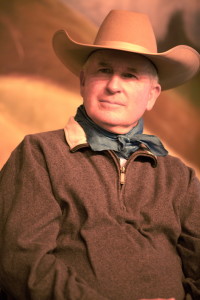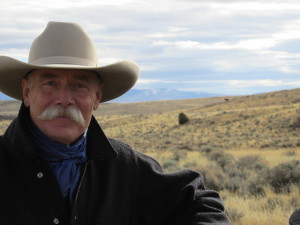 Randy Rieman fulfilled his childhood dream of becoming a horseman when, in his early 20’s he left the midwest and traveled to Montana. With a keen willingness to work hard and an enthusiasm for learning, he connected with many fine horseman, including Bill and Tom Dorrance in California. For the past 30 years, he has honed his craft in California, New Mexico, Hawaii, and, of course, Montana, which he now calls home. Along the way, he’s also risen to the top as a rawhide braider and a cowboy poetry reciter. He travels nationally and internationally to share what he’s learned.
Randy Rieman fulfilled his childhood dream of becoming a horseman when, in his early 20’s he left the midwest and traveled to Montana. With a keen willingness to work hard and an enthusiasm for learning, he connected with many fine horseman, including Bill and Tom Dorrance in California. For the past 30 years, he has honed his craft in California, New Mexico, Hawaii, and, of course, Montana, which he now calls home. Along the way, he’s also risen to the top as a rawhide braider and a cowboy poetry reciter. He travels nationally and internationally to share what he’s learned.
Read about his Dorrance memories.
Read about Randy, as a Renaissance Man.
In this third installment, Rieman discusses the state of horsemanship learning in today’s age and describes his strategies for having a fresh, willing horse.
Register for Randy Rieman Clinic, September 24-26. Click here.
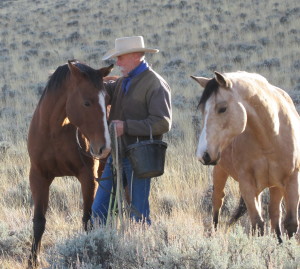 Randy Rieman: The average person today can get more information now. The problem with that is, it’s just information. It has to get turned into knowledge. And that application of doing that is: you’ve got to develop feel so that you know what it feels like when they’re making those changes.
Randy Rieman: The average person today can get more information now. The problem with that is, it’s just information. It has to get turned into knowledge. And that application of doing that is: you’ve got to develop feel so that you know what it feels like when they’re making those changes.
BestHorsePractices asks: We learn that the only way the only way you’re going to do that is two ways: by getting help from an expert, or someone that’s better than you, and, by riding not just your horse, but a lot of different horses.
RR: That’s the thing I’ve been doing with an apprentice, getting her on as many different horses as I can, so that she realizes how different each one feels and how much it requires to move one and how little it requires to move another.
BHP: Most readers have one horse and they don’t have the luxury of having a remuda. What would you recommend, riding your friends’ horses?
RR: Yeah, switchin’ out. Bryan Neubert and I used to do this all the time:
“Hey, switch horses with me! Tell me what this feels like to you.”
We just switched, you know, and then, “Oh, that feels pretty good. How’d you get that?”
“Well, try this. Do a little of this and see what you get.”
That comparative shopping kind of thing is really cool stuff. You start to build a confidence level.
If you own one horse and are constantly training that poor horse, the horse gets so tired of it, too. The horse just gets where “I don’t want to see you anymore.”
You know what I try to do? I don’t have a pattern. I don’t tell myself I’m going to train my horse today. As I’m riding, I’m thinking :
- I want to move the hip over here
- I want to slow the feet down
- I want to extend the stride
- I’d like to change the position of his head and neck.
And so I might walk right now, I might trot then, I might make lots of speed and direction changes — all so that my horse can’t recognize a pattern in what I’m doing.
Like opening a gate: there are about 900 ways to open a gate. And so I just make sure I open it a different 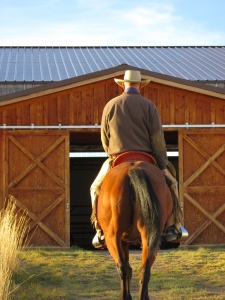 way every time:
way every time:
- I go left side.
- I go right side.
- I go head toward the hinge.
- I go hip toward the hinge.
- I walk the gate toward me.
- I walk the gate away from me.
Every time I open the gate, I don’t want to get ten feet from the gate and have the horse set up in the spot where he’s always opening the gate.
BHP: You’re intentionally eclectic? Intentionally unpredictable?
RR: Yes, sometimes I saddle ’em up and tie ’em to the fence and I don’t even ride ’em. Just leave ’em alone. Til they’re kind of on three legs, then I might turn ’em loose.
BHP: And what do you mean by three legs, dopey?
RR: Asleep. They’re just sittin’ in the sun enjoying the day, you know. If they’re whinnying or pawing or anxious, I just leave them there until they’re not. I call it the Patience Pole. And they’re separated from all the other horses, they’re outside, and they have to learn to wait on me. That’s a big thing for me.
They can learn to wait patiently, just like when I stop at a gate, they have to wait till I open the latch. They don’t get to leave while I’m opening 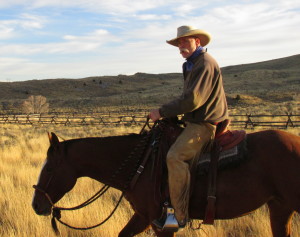 the latch. They’ve got to wait till I’m done.
the latch. They’ve got to wait till I’m done.
But then I take them somewhere before they take me. So now there’s purpose in the waiting. It’s like the clicker training with the dog. First, you give the reward right away, and then you get five or six maneuvers before you give the reward. You can delay the reward longer and longer as the horse gets more and more sure of his job.
I can make a request and wait for him to comply and reward the compliance. Now he’s moving and he’s complying more quickly and it takes less pressure. He sustains the request longer. He knows that moving in that direction is moving toward freedom.
The thing I fear is what happens with a lot of intellectual knowledge, as opposed to experiential knowledge: you start thinking it’s good enough. Readers and riders have to really be aware they’re not spending more time gaining intellectual information than they are trying to apply that
information with their horse.
I really appreciated Ray Hunt when somebody asked him, “Which one of your videos should I get?” And he replied, “I wouldn’t get any of ’em, I’d just go ride my horse.”
